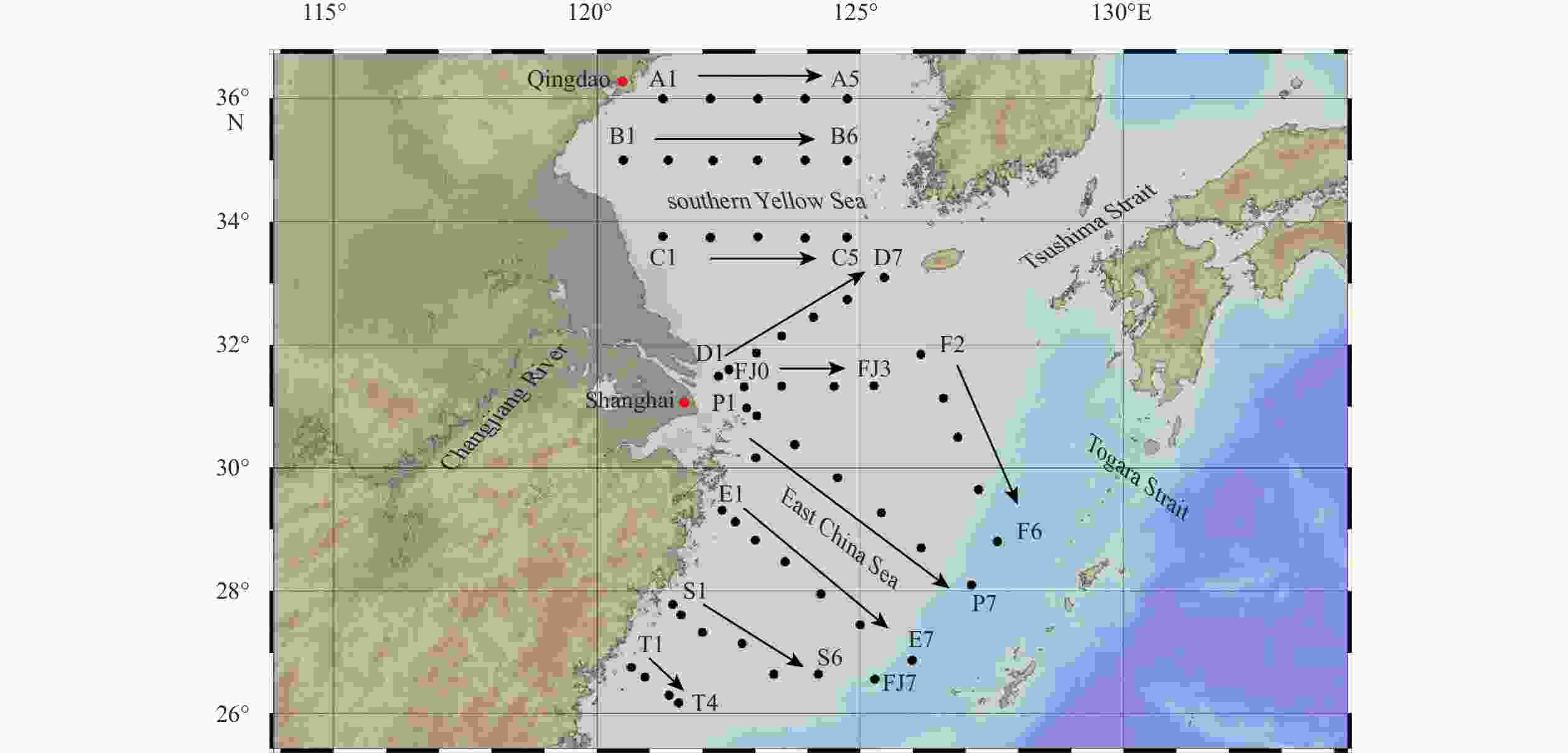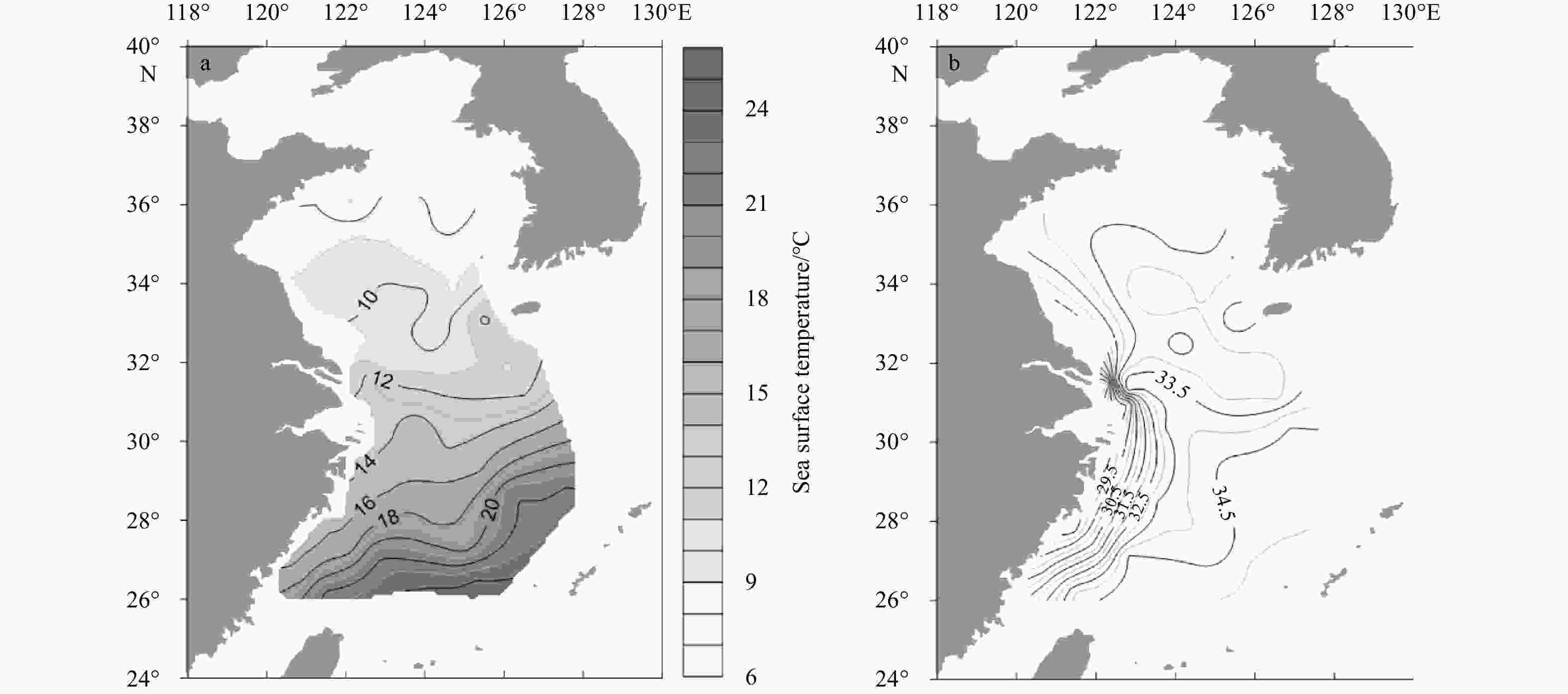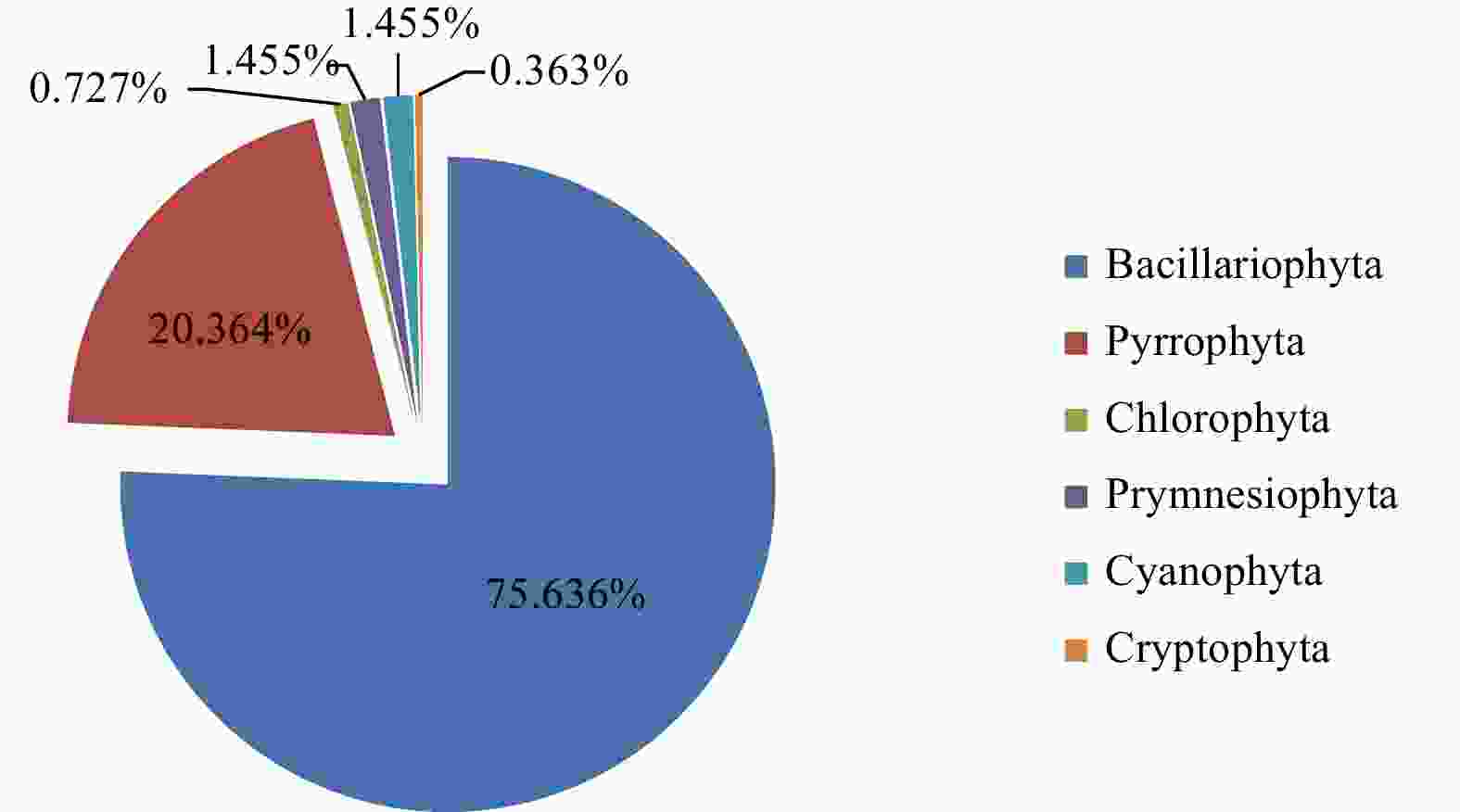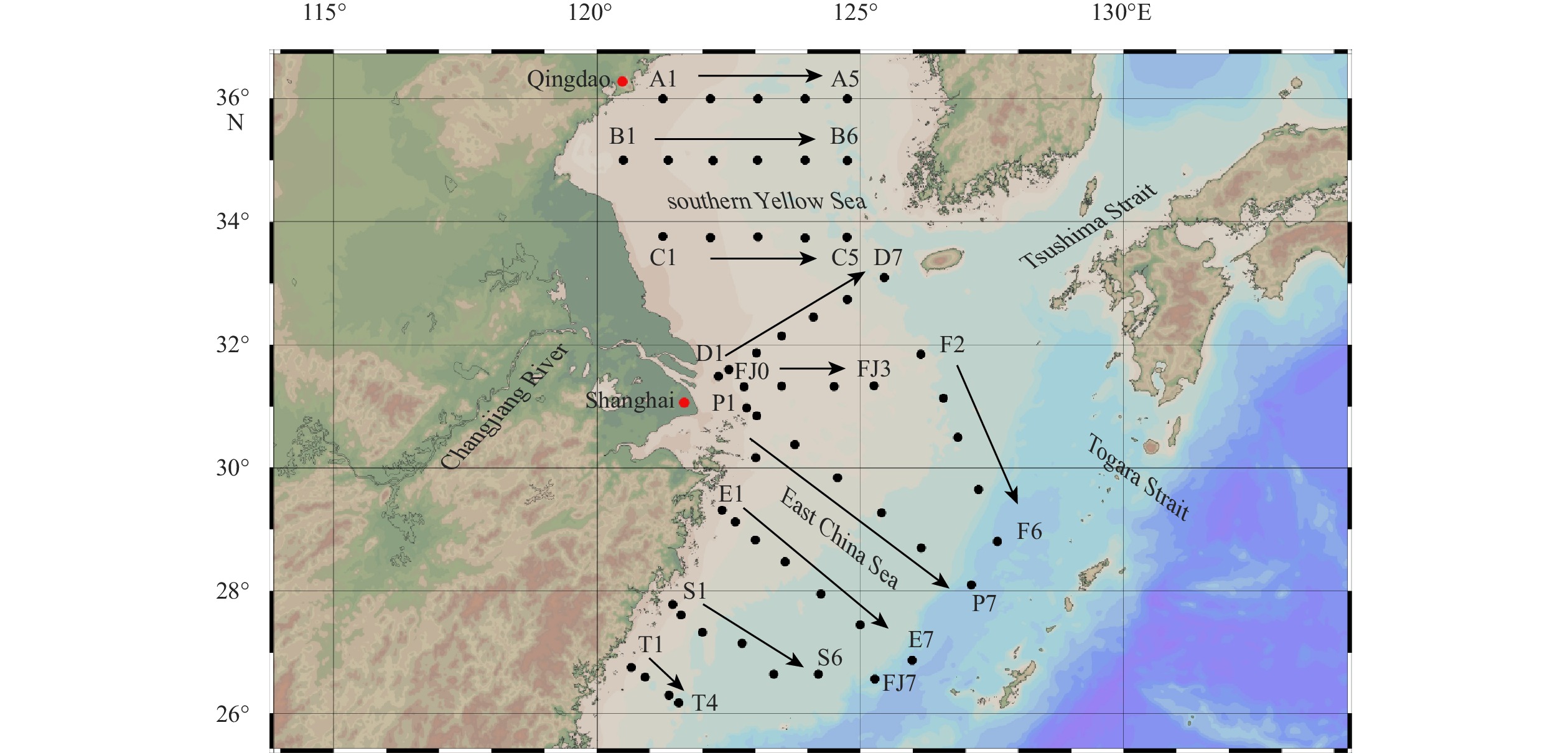Distribution of phytoplankton in the East China Sea and the southern Yellow Sea in spring in relation to environmental variables and dimethylsulfide compounds
-
Abstract: The coastal ecosystems are highly sensitive to climate change and are usually influenced by variations in phytoplankton communities and water physiochemical factors. In the present study, the phytoplankton community, chlorophyll a (Chl a) and their relationships with environmental variables and dimethylsulfide (DMS) and dimethylsulfoniopropionate (DMSP) were investigated in spring 2017 (March 24 to April 16) in the East China Sea (26.0°–33.0°N, 120.0°–128.0°E) and southern Yellow Sea (31.0°–36.0°N, 120.0°–125.0°E). The spatial distributions of phytoplankton species composition and cell density were investigated by qualitative and quantitative methods and were compared with historical data to study phytoplankton species succession in the survey area. The results showed that there were 275 phytoplankton species belonging to 90 genera and 6 phyla in the survey area, of which 208 species belonged to 62 genera of Bacillariophyta and 56 species belonged to 20 genera of Pyrrophyta. The dominant phytoplankton species were Skeletonema dohrnii, Chaetoceros vanheurckii and Prorocentrum donghaiense. The phytoplankton cell densities ranged from 0.06×104 cells/L to 418.73×104 cells/L, with an average value of 21.46×104 cells/L. In spring, the average ratio of Bacillariophyta/Pyrrophyta was 41.13 for the entire study area. The areas with high phytoplankton cell density were mainly distributed in the northern South Yellow Sea and offshore waters of the East China Sea. According to a canonical correspondence analysis among phytoplankton and environmental parameters, the water Chl a concentrations were notably consistent with phytoplankton cell density (P<0.001), and both showed significant negative correlations with salinity and nitrite (P<0.05) and significant positive correlations with dissolved oxygen and pH (P<0.001). There was a significant positive correlation between diatom (both in cell density and in dominant species) and DMS (P<0.05), which indicated that diatoms play a greater role in DMS production in this investigated area.
-
Key words:
- phytoplankton /
- distribution /
- East China Sea /
- southern Yellow Sea /
- dimethylsulfoniopropionate
-
Figure 7. Correlation analysis of phytoplankton, environmental factors and sulfide in seawater. a. Correlation analysis of phytoplankton diversity with temperature, salinity and nutrients; b. correlation analyses of phytoplankton diversity with DO, pH, Chl a concentration and dimethyl sulfide concentration. Density represents phytoplankton density; S-W, Shannon-Wiener diversity index;
${\rm{N}}{\rm{H}}^+_{4}\text{-}{\rm{N}}$ , ammonium nitrogen;${\rm{N}}{\rm{O}}^-_{2}\text{-}{\rm{N}}$ : nitrate nitrogen;${\rm{P}}{\rm{O}}^{3-}_{4}\text{-}{\rm{N}}$ , phosphate phosphorus;${\rm{S}}{\rm{i}}{\rm{O}}^{2-}_{3}\text{-}{\rm{S}} {\rm{i}}$ , silicate silicon; B/P, Bacillariophyta cell density/Pyrrophyta cell density; DO, dissolved oxygen; Chl a: Chlorophyll a concentration; pH, potential of hydrogen; DMS, dimethylsulfide; DMSPd, dissolved dimethylsulfoniopropionate; DMSPp, particle dimethylsulfoniopropionate; DMSOd, dissolved dimethyl sulfoxide; DMSOp, particle dimethyl sulfoxide. Blue numbers indicate negative correlations; red numbers, positive correlations. * denotes P<0.05; **, P<0.01; and ***, P<0.001. The coordinate axis value in the figure indicates the parameters of the diagonal.Figure 8. Biplot of the canonical correspondence analysis results for dominant phytoplankton cell density (a), sampling stations (b) and environmental variables (→). Numbers with letters represent the relevant species: SP1, Bacteriastrum hyalinum; SP2, Chaetoceros castracanei; SP3, C. curvisetus; SP4, C. debilis; SP5, C. densus; SP6, C. diadema; SP7, C. lorenzianus; SP8, C. muelleri; SP9, C. pelagicus; SP10, C. pseudocurvisetus; SP11, C. vanheurckii; SP12, Cyclotella striata; SP13, Frustulia interposita var. chinensis; SP14, Leptocylindrus danicus; SP15, Melosira moniliformis; SP16, Nitzschia closterium; SP17, N. longissima; SP18, Paralia sulcata; SP19, P. donghaiense; SP20, P. micans; SP21, P. minimun; SP22, Pseudo-nitzschia delicatissima; SP23, Skeletonema costatum; SP24, S. dohrnii; SP25, S. marinol; SP26, S. munzelii; SP27, Thalassiosira rotula; SP28, Thalassiosira sp.; and SP29, Trichodesmium hildebrandtii. Chl a represents Chlorophyll a concentration; Density, sampling station phytoplankton density.
Table 1. Dominant species of phytoplankton in the East China Sea and the southern Yellow Sea
Dominant species Cell density
/(104 cells·L-1)Frequency
(fi)Dominance
(Y)Skeletonema dohrnii 8.05 0.34 0.03 Chaetoceros vanheurckii 1.94 0.38 0.14 Prorocentrum donghaiense 0.68 0.77 0.02 Table 2. Comparisons of the average Chl a concentration in this study and other investigations in the Yellow Sea (YS) and the East China Sea (ECS)
Investigation area Investigation time Average Chl a concentration/(μg·L−1) References SYS, ECS 2017 1.10 this study SYS, northern of ECS 2011 1.43 Wen et al. (2012) YS, ECS 2006–2007 1.17 Wang (2011) SYS, ECS 2000–2001 0.75 Huang et al. (2006) Note: SYS is the abbreviation of the South Yellow Sea. Table 3. Comparison of species number, cell density and dominant species of the same survey area in this study and other studies
Sampling time Survey area Species
numberCell density/
(104 cells·L−1)Dominant species References April, 2017 26°–36°N, 120°–128°E 275 21.46 Skeletonema dohrnii, Chaetoceros vanheurckii, Prorocentrum donghaiense this study May, 2011 25°00'–33°30'N,
120°00'–127°30'E193 6.69 Prorocentrum dentatum, Pseudo-nitzschia delicatissim, Skeletonema sp., Paralia sulcata, Prorocentrum minimum, Gymnodinium lohmanni, Coscinodiscus sp., Chaetoceros curvisetus Zhao et al. (2015) April, 2009 30°30'–32°00'N,
121°00'–123°30'E64 58.22 Skeletonema dohrnii, Paralia sulcata, Thalassionema nitzschioides, Pseudo-nitzschia pungens Sun and Tian (2011) May, 2008 26°50'–34°07'N,
120°50'–123°59'E155 26.63 Prorocentrum dentatum, Skeletonema costatum, Scrippsiella trochoidea, Paralia sulcata Tian et al. (2010) May, 2007 26°50'–34°00'N,
120°50'–124°00'E144 7.89 Pseudo-nitzschia delicatissim, Prorocentrum dentatum, Skeletonema costatum, Thalassiosira rotula Tan et al. (2009) June–July, 2006 25°00'–39°00'N,
118°00'–129°00'E136 0.84 Thalassiosira scrotiformis, Pseudo-nitzschia pungens Zhou (2014); Zhou et al. (2015) June, 2006 26°00'–34°00'N,
121°00'–126°00'E130 14.70 Prorocentrum dentatum, Karenia mikimotoi, Pseudo-nitzschia pungens, Pseudo-nitzschia. delicatissima Wang et al. (2008) May, 2005 30°30'–32°30'N,
121°00'–123°30'E92 36.18 Karenia mikimotoi, Skeletonema costatum, Prorocentrum dentatum Luan (2007) May, 2002–June, 2005 (Spring) 27°00'–32°00'N,
122°00'–123°30'E162 – Paralia sulcate, Nitzschia spp., Pseudo-nitzschia spp., Pseudo-nitzschia delicatissima, Pseudo-nitzschia pungens, Thalassiosira spp., Thalassiosira rotula, Skeletonema costatum, Coscinodiscus spp., Chaetoceros spp. Xie (2007) April, 1998 23°30'–33°00'N,
118°30'–128°00'E– 0.002 Chaetoceros lorenzianus, Noctiluca scintillans Luo et al. (2007) 1960, 1971 27°–34°N,
the west of 127°E– – Rhizosolenia styliformis, Guinardia cylindrus, Climacodium biconcavum Chen et al. (1980) Note: – represents no data. -
[1] Alcolombri U, Ben-Dor S, Feldmesser E, et al. 2015. Identification of the algal dimethyl sulfide-releasing enzyme: a missing link in the marine sulfur cycle. Science, 348(6242): 1466–1469. doi: 10.1126/science.aab1586 [2] Alcolombri U, Laurino P, Lara-Astiaso P, et al. 2014. DddD is a CoA-Transferase/Lyase producing dimethyl sulfide in the marine environment. Biochemistry, 53(34): 5473–5475. doi: 10.1021/bi500853s [3] Anderson D M, Glibert P M, Burkholder J M. 2002. Harmful algal blooms and eutrophication: nutrient sources, composition, and consequences. Estuaries, 25(4): 704–726. doi: 10.1007/BF02804901 [4] Andreae M O, Crutzen P J. 1997. Atmospheric aerosols: biogeochemical sources and role in atmospheric chemistry. Science, 276(5315): 1052–1058. doi: 10.1126/science.276.5315.1052 [5] Archer S D, Kimmance S A, Stephens J A, et al. 2013. Contrasting responses of DMS and DMSP to ocean acidification in Arctic waters. Biogeosciences, 10(3): 1893–1908. doi: 10.5194/bg-10-1893-2013 [6] Aubry F B, Cossarini G, Acri F, et al. 2012. Plankton communities in the northern Adriatic Sea: patterns and changes over the last 30 years. Estuarine, Coastal and Shelf Science, 115: 125–137, [7] Caruana A M N, Malin G. 2014. The variability in DMSP content and DMSP lyase activity in marine dinoflagellates. Progress in Oceanography, 120: 410–424. doi: 10.1016/j.pocean.2013.10.014 [8] Charlson R J, Lovelock J E, Andreae M O, et al. 1987. Oceanic phytoplankton, atmospheric sulphur, cloud albedo and climate. Nature, 326(6114): 655–661. doi: 10.1038/326655a0 [9] Chen-Tung Arthur Chen. 2009. Chemical and physical fronts in the Bohai, Yellow and East China seas. Journal of Marine Systems, 78(3): 394–410. doi: 10.1016/j.jmarsys.2008.11.016 [10] Chen Yanghang. 2017. Ecological characteristics of phytoplankton and physiological mechanism of interspecies relationship between the key phytoplankton species in a scallop culture sea area of Bohai Bay (in Chinese)[dissertation]. Xiamen: Xiamen University [11] Chen Qingchao, Chen Yaqu, Hu Yazhu. 1980. Preliminary study on the plankton communities in the southern Yellow Sea and the East China Sea. Haiyang Xuebao (in Chinese), 2(2): 149–157 [12] Chen Peng, Pan Delu, Mao Zhihua. 2015. Application of a laser fluorometer for discriminating phytoplankton species. Optics & Laser Technology, 67: 50–56. doi: 10.1016/j.optlastec.2014.09.013 [13] Chen Baohong, Xu Zhuhua, Zhou Qiulin, et al. 2010. Long-term changes of phytoplankton community in Xiagu waters of Xiamen, China. Acta Oceanologica Sinica, 29(6): 104–114. doi: 10.1007/s13131-010-0081-4 [14] Cheng Zhaodi, Gao Yahui, Liu Shicheng, et al. 2013a. Flora Algarum Marinarum Sinicarum. Tomus V. Bacillariophyta, No. III. Pennatae II. Naviculales, Naviculaceae, Cymbellaceae, Auriculaceae, Gomphonemaceae (in Chinese). Beijing: Science Press [15] Cheng Zhaodi, Gao Yahui, Liu Shicheng, et al. 2013b. Flora Algarum Marinarum Sinicarum, Tomus V. Bacillariophyta, No. II. Pennatae I. Diatomales, Achnanthales, Phaeodactylales, Eunotiales (in Chinese). Beijing: Science Press [16] Chiang Kuo-Ping, Chen Ying-Tun, Gong Gwo-Ching. 1999. Spring distribution of diatom assemblages in the East China Sea. Marine Ecology Progress Series, 186: 75–86. doi: 10.3354/meps186075 [17] Chiang Kuo-Ping, Chou Yu-Hsuan, Chang Jeng, et al. 2004. Winter distribution of diatom assemblages in the East China Sea. Journal of Oceanography, 60(6): 1053–1062. doi: 10.1007/s10872-005-0013-7 [18] Chinese Society of Oceanography. 2015. History of Oceanography in China (in Chinese). Beijing: China Science and Technology Press [19] Cho B C, Choi J K, Chung C S, et al. 1994. Uncoupling of bacteria and phytoplankton during a spring diatom bloom in the mouth of the Yellow Sea. Marine Ecology Progress Series, 115(1): 181–190. doi: 10.3354/meps115181 [20] Dacey J W H, Blough N V. 1987. Hydroxide decomposition of dimethylsulfoniopropionate to form dimethylsulfide. Geophysical Research Letters, 14(12): 1246–1249. doi: 10.1029/GL014i012p01246 [21] Deng Xuwei, Chen Juan, Hansson L A, et al. 2021. Eco-chemical mechanisms govern phytoplankton emissions of dimethylsulfide in global surface waters. National Science Review, 8(2): nwaa140. doi: 10.1093/nsr/nwaa140 [22] do Rosario Gomes H, Xu Qian, Ishizaka J, et al. 2018. The influence of riverine nutrients in niche partitioning of phytoplankton communities—A contrast between the Amazon River plume and the Changjiang (Yangtze) River diluted water of the East China Sea. Frontiers in Marine Science, 5: 343. doi: 10.3389/fmars.2018.00343 [23] Du Xiaoming, Liu Houtian, Liu Ruoan, et al. 1998. The flux of oceanic dimethyl sulfide from coastal area in Xiamen to the atmosphere. Research of Environmental Sciences, 11(2): 34–36 [24] Duan Shanshan, Xing Lei, Zhang Hailong, et al. 2014. Upwelling and anthropogenic forcing on phytoplankton productivity and community structure changes in the Zhejiang coastal area over the last 100 years. Acta Oceanologica Sinica, 33(10): 1–9. doi: 10.1007/s13131-014-0535-1 [25] Falkowski P G, Woodhead A D, Vivirito K. 1992. Primary Productivity and Biogeochemical Cycles in the Sea. New York: Plenum Press [26] Findlay D L, Kasian S E M, Turner M T, et al. 1999. Responses of phytoplankton and epilithon during acidification and early recovery of a lake. Freshwater Biology, 42(1): 159–175. doi: 10.1046/j.1365-2427.1999.00458.x [27] Furuya K, Kurita K, Odate T. 1996. Distribution of phytoplankton in the East China Sea in the winter of 1993. Journal of Oceanography, 52(3): 323–333. doi: 10.1007/BF02235927 [28] General Administration of Quality Supervision, Inspection and Quarantine of the People’s Republic of China, Standardization Administration. 2008. GB/T 12763.6–2007 Specifications for Oceanographic Survey—Part 6: Marine Biological Survey. Beijing: Standards Press of China, 159 [29] Guan Bingxian. 1984. Major features of the shallow water hydrography in the East China Sea and Huanghai Sea. Elsevier Oceanography Series, 39: 1–13. doi: 10.1016/S0422-9894(08)70288-5 [30] Guan Bingxian. 1994. Patterns and structures of the currents in Bohai, Huanghai and East China Seas. In: Zhou Di, Liang Yuanbo, Zeng Chengkui, eds. Oceanology of China Seas. Dordrecht: Springer, 17–26. doi: 10.1007/978-94-011-0862-1_3 [31] Guo Yujie. 1963. The nature of Chaetoceros flora of the Yellow Sea. Oceanologia et Limnologia Sinica, 6(4): 322–332 [32] Guo Shujin. 2012. Study on phytoplankton assemblage in the East China Sea (in Chinese)[dissertation]. Qingdao: Ocean University of China [33] Guo Yujie, Qian Shuben. 2003. Flora Algarum Marinarum Sinicarum, Tomus Ⅴ. Bacillariophyta No. I. Centricae (in Chinese). Beijing: Science Press [34] Guo Shujin, Tian Wei, Dai Minhan, et al. 2011. Phytoplankton assemblages in the East China Sea in summer 2009. Advances in Marine Science, 29(4): 474–486. doi: 10.3969/j.issn.1671-6647.2011.04.007 [35] Hays G C, Richardson A J, Robinson C. 2005. Climate change and marine plankton. Trends in Ecology & Evolution, 20(6): 337–344. doi: 10.1016/j.tree.2005.03.004 [36] Hoegh-Guldberg O, Jacob D, Taylor M, et al. 2018. Impacts of 1.5°C global warming on natural and human systems. In: Masson-Delmotte V, Zhai P, Pörtner H O, et al, eds. Global Warming of 1.5°C. https://unfccc.int/topics/science/workstreams/cooperation-with-the-ipcc/ipcc-special-report-on-global-warming-of-15-degc[2020-03-12] [37] Hu Min, Tang Xiaoyan, Li Jinlong. 1995. Measurement of dimethyl sulfide in the Bo Sea and Gulf of Jiaozhou. Pure and Applied Chemistry, 67(8–9): 1481–1486 [38] Hu Min, Tang Xiaoyan, Li Jinlong, et al. 1997. Dimethylsulfide in sea water in the Gulf of Jiaozhou. Acta Scientiae Circumstantiae, 17(1): 110–115 [39] Huang Zongguo, Lin Mao. 2012. The Living Species and Their Illustrations in China’s Seas (Part Ⅱ), an Illustrated Guide to Species in China’s Seas Vol. 1 (in Chinese). Beijing: China Ocean Press [40] Huang Bangqin, Liu Yuan, Chen Jixin, et al. 2006. Temporal and spatial distribution of size-fractionized phytoplankton biomass in East China Sea and Huanghai Sea. Haiyang Xuebao (in Chinese), 28(2): 156–164. doi: 10.3321/j.issn:0253-4193.2006.02.021 [41] Huang Wenxiang, Sheng Liangfu, Zhu Lin. 1984. Phytoplankton in the Yellow Sea. Marine Environmental Science, 3: 19–28 [42] Jia Haibo, Shao Junbo, Hu Haoyan, et al. 2014. Changes and reason analysis of phytoplankton community structure in the Yangtze Estuary and adjacent sea before and after the impoundment of the Three Gorges Dam. Marine Science Bulletin, 33(3): 305–314. doi: 10.11840/j.issn.1001-6392.2014.03.009 [43] Jian Shan, Zhang Honghai, Yang Guipeng, et al. 2019. Variation of biogenic dimethylated sulfur compounds in the Changjiang River Estuary and the coastal East China Sea during spring and summer. Journal of Marine Systems, 199: 103222. doi: 10.1016/j.jmarsys.2019.103222 [44] Jian Shan, Zhang Honghai, Zhang Jing, et al. 2018. Spatiotemporal distribution characteristics and environmental control factors of biogenic dimethylated sulfur compounds in the East China Sea during spring and autumn. Limnology and Oceanography, 63(S1): S280–S298. doi: 10.1002/lno.10737 [45] Jiang Rui, Wang Youshao. 2018. Modeling the ecosystem response to summer coastal upwelling in the northern South China Sea. Oceanologia, 60(1): 32–51. doi: 10.1016/j.oceano.2017.05.004 [46] Jiao Nianzhi, Liu Chengzheng, Hong Huasheng, et al. 2003. Dynamics of dimethylsulfide and dimethylsulfoniopropionate produced by phytoplankton in the Chinese seas—Distribution patterns and affecting factors. Acta Botanica Sinica, 45(7): 774–786 [47] Jin Xiaoying, Yuan Dongxing, Chen Meng, et al. 2004. Distribution of dimethylsulfide of Xiamen sea surface water in spring. Marine Environmental Science, 23(2): 12–15 [48] Karsten U, Kirst G O, Wiencke C. 1992. Dimethylsulphoniopropionate (DMSP) accumulation in green macioalgae from polar to temperate regions: interactive effects of light versus salinity and light versus temperature. Polar Biology, 12(6): 603–607. doi: 10.1007/BF00236983 [49] Karsten U, Kück K, Vogt C, et al. 1996. Dimethylsulfoniopropionate production in phototrophic organisms and its physiological functions as a cryoprotectant. In: Kiene R P, Visscher P T, Keller M D, et al, eds. Biological and Environmental Chemistry of DMSP and Related Sulfonium Compounds. Boston: Springer, 143–153 [50] Kiene R P, Gerard G. 1994. Determination of trace levels of dimethylsulfoxide (DMSO) in seawater and rainwater. Marine Chemistry, 47(1): 1–12. doi: 10.1016/0304-4203(94)90009-4 [51] Kiene R P, Slezak D. 2006. Low dissolved DMSP concentrations in seawater revealed by small-volume gravity filtration and dialysis sampling. Limnology and Oceanography: Methods, 4(4): 80–95. doi: 10.4319/lom.2006.4.80 [52] Kirst G O. 1990. Salinity tolerance of eukaryotic marine algae. Annual Review of Plant Physiology and Plant Molecular Biology, 41: 21–53. doi: 10.1146/annurev.pp.41.060190.000321 [53] Koblentz-Mishke O J, Volvovinsky V V, Kabanova J G. 1970. Plankton primary production of the world ocean. In: Wooster W S, ed. Scientific Exploration of the South Pacific. Washington: National Academy of Sciences, 183–193 [54] Lammers J M, van Soelen E E, Donders T H, et al. 2013. Natural environmental changes versus human impact in a Florida estuary (Rookery Bay, USA). Estuaries and Coasts, 36(1): 149–157. doi: 10.1007/s12237-012-9552-5 [55] Lampitt R S, Wishner K F, Turley C M, et al. 1993. Marine snow studies in the Northeast Atlantic Ocean: distribution, composition and role as a food source for migrating plankton. Marine Biology, 116(4): 689–702. doi: 10.1007/BF00355486 [56] Leira M, Sabater S. 2005. Diatom assemblages distribution in catalan rivers, NE Spain, in relation to chemical and physiographical factors. Water Research, 39(1): 73–82. doi: 10.1016/j.watres.2004.08.034 [57] Li Chaolun, Luan Fenghe. 1998. A proliminary study on the distribution of size-fractionated chlorophyll-a in the euphotic zone of the East China Sea in spring. Marine Sciences, (4): 59–62 [58] Li Wei, Wang Yuheng, Wang Jianing, et al. 2012. Distributions of water masses and hydrographic structures in the Yellow Sea and East China Sea in spring and summer 2011. Oceanologia et Limnologia Sinica, 43(3): 615–623 [59] Liu Chao, Kang Jiancheng, Wang Guodong, et al. 2012. Monthly change of nutrients impact on phytoplankton in Kuroshio of East China Sea. Energy Procedia, 16: 1193–1198. doi: 10.1016/j.egypro.2012.01.190 [60] Liu Yue, Liu Chunying, Yang Guipeng, et al. 2016. Biogeochemistry of dimethylsulfoniopropionate, dimethylsulfide and acrylic acid in the Yellow Sea and the Bohai Sea during autumn. Environmental Chemistry, 13(1): 127–139. doi: 10.1071/EN15025 [61] Liu Ruiyu, Xu Fengshan. 1963. Preliminary studies on the benthic fauna of the Yellow Sea and the East China Sea. Oceanologia et Limnologia Sinica, 5(4): 306–321 [62] Lu Douding, Goebel J. 2001. Five red tide species in genus Prorocentrum including the description of Prorocentrum donghaiense Lu SP. nov. from the East China Sea. Chinese Journal of Oceanology and Limnology, 19(4): 337–344. doi: 10.1007/BF02850738 [63] Luan Qingshan. 2007. Ecological study on phytoplankton assemblage in Changjiang River Estuary and its adjacent waters (in Chinese)[dissertation]. Qingdao: Ocean University of China [64] Luo Minbo, Lu Jianjian, Wang Yunlong, et al. 2007. Horizontal distribution and dominant species of phytoplankton in the East China Sea. Acta Ecologica Sinica, 27(12): 5076–5085. doi: 10.3321/j.issn:1000-0933.2007.12.016 [65] Ma Qiju. 2004. The emission of dimethyl sulfur and its contribution to sulfate in China offshore (in Chinese)[dissertation]. Beijing: Peking University [66] Ma Sha. 2018. Studies on responses of phytoplankton and community structure to ocean acidification (in Chinese)[dissertation]. Shanghai: Shanghai Ocean University [67] Ma Qiju, Hu Min, Tian Xudong, et al. 2004. Dimethylsulfide emission in Qingdao near-shore waters and atmospheric dimethylsulfide concentration variation. Environmental Science, 25(1): 20–24 [68] Najjar R G, Pyke C R, Adams M B, et al. 2010. Potential climate-change impacts on the Chesapeake Bay. Estuarine, Coastal and Shelf Science, 86(1): 1–20, [69] Najjar R G, Walker H A, Anderson P J, et al. 2000. The potential impacts of climate change on the mid-Atlantic coastal region. Climate Research, 14(3): 219–233 [70] Nick F M, Vieli A, Andersen M L, et al. 2013. Future sea-level rise from Greenland’s main outlet glaciers in a warming climate. Nature, 497(7448): 235–238. doi: 10.1038/nature12068 [71] Nishiguchi M K, Somero G N. 1992. Temperature- and concentration-dependence of compatibility of the organic osmolyte β-dimethylsulfoniopropionate. Cryobiology, 29(1): 118–124. doi: 10.1016/0011-2240(92)90011-P [72] Noman M A, Sun Jun, Gang Qian, et al. 2019. Factors regulating the phytoplankton and tintinnid microzooplankton communities in the East China Sea. Continental Shelf Research, 181: 14–24. doi: 10.1016/j.csr.2019.05.007 [73] Norse E A. 1993. Global Marine Biological Diversity: A Strategy for Building Conservation into Decision Making. Washington: Island Press [74] Parsons T R, Maita Y, Lalli C M. 1984. A Manual of Chemical and Biological Methods for Seawater Analysis. Oxford: Pergamon Press [75] Pielou E C. 1969. An Introduction to Mathematical Ecology. New York: Wiley-Interscience [76] Qi Yuzao, Wang Yan. 2003. What the Prorocentrum species should be? —A review on identification of a Prorocentrum species from the East China Sea. Chinese Journal of Applied Ecology, 14(7): 1188–1190 [77] Qu Bo, Yang Guipeng, Guo Liyan, et al. 2020. The satellite derived environmental factors and their relationships with dimethylsulfide in the east marginal seas of China. Journal of Marine Systems, 204: 103305. doi: 10.1016/j.jmarsys.2020.103305 [78] Reynolds C S. 1984. Phytoplankton periodicity: the interactions of form, function and environmental variability. Freshwater Biology, 14(2): 111–142. doi: 10.1111/j.1365-2427.1984.tb00027.x [79] Round F, Crawford R M, Mann D G. 1990. The Diatoms, Biology and Morphology of the Genera. Cambridge: Cambridge University Press [80] Sarmiento J L, Toggweiler J R, Najjar R. 1988. Ocean carbon-cycle dynamics and atmospheric Pco2. Philosophical Transactions of the Royal Society A: Mathematical, Physical and Engineering Sciences, 325(1583): 3–21, [81] Schaffer G, Leth O, Ulloa O, et al. 2000. Warming and circulation change in the eastern South Pacific Ocean. Geophysical Research Letters, 27(9): 1247–1250. doi: 10.1029/1999GL010952 [82] Sekerc Y, Ozarslan R. 2020. Oxygen-plankton model under the effect of global warming with nonsingular fractional order. Chaos, Solitons & Fractals, 132: 109532, [83] Shannon C E. 1948. A mathematical theory of communication. The Bell System Technical Journal, 27(4): 623–656. doi: 10.1002/j.1538-7305.1948.tb00917.x [84] Shannon C E, Weaver W. 1949. The Mathematical Theory of Communication. Urbana, IL: University of Illinois Press [85] Simó R. 2001. Production of atmospheric sulfur by oceanic plankton: biogeochemical, ecological and evolutionary links. Trends in Ecology Evolution, 16(6): 287–294. doi: 10.1016/S0169-5347(01)02152-8 [86] Song Shuqun. 2010. Phytoplankton functional groups in the Yellow Sea and the East China Sea (in Chinese)[dissertation]. Beijing: Chinese Academy of Sciences [87] Song Shuqun, Li Zhao, Li Caiwen, et al. 2017. The response of spring phytoplankton assemblage to diluted water and upwelling in the eutrophic Changjiang (Yangtze River) Estuary. Acta Oceanologica Sinica, 36(12): 101–110. doi: 10.1007/s13131-017-1094-z [88] Spiese C E, Kieber D J, Nomura C T, et al. 2009. Reduction of dimethylsulfoxide to dimethylsulfide by marine phytoplankton. Limnology and Oceanography, 54(2): 560–570. doi: 10.4319/lo.2009.54.2.0560 [89] Stefels J. 2000. Physiological aspects of the production and conversion of DMSP in marine algae and higher plants. Journal of Sea Research, 43(3–4): 183–197. doi: 10.1016/S1385-1101(00)00030-7 [90] Stefels J, Steinke M, Turner S, et al. 2007. Environmental constraints on the production and removal of the climatically active gas dimethylsulphide (DMS) and implications for ecosystem modelling. In: van Leeuwe M A, Stefels J, Belviso B, eds. Phaeocystis, Major Link in the Biogeochemical Cycling of Climate-Relevant Elements. Dordrecht: Springer, 245–275. doi: 10.1007/978-1-4020-6214-8_18 [91] Stefels J, van Leeuwe M A. 1998. Effects of iron and light stress on the biochemical composition of Antarctic Phaeocystis sp. (Prymnesiophyceae). Ⅰ. Intracellular DMSP concentrations. Journal of Phycology, 34(3): 486–495. doi: 10.1046/j.1529-8817.1998.340486.x [92] Sun Jun. 2011. Marine phytoplankton and biological carbon sink. Acta Ecologica Sinica, 31(18): 5372–5378 [93] Sun Jun, Tian Wei. 2011. Phytoplankton in Yangtze River Estuary and its adjacent waters in spring in 2009: species composition and size-fractionated chlorophyll a. Chinese Journal of Applied Ecology, 22(1): 235–242 [94] Tan Shujie, Gong Xiangzhong, Sun Jun, et al. 2009. The phytoplankton community in spawning ground of the East China Sea and its adjacent waters in spring. Marine Sciences, 33(8): 5–10 [95] Taylor J C, Prygiel J, Vosloo A, et al. 2007. Can diatom-based pollution indices be used for biomonitoring in South Africa? A case study of the Crocodile West and Marico water management area. Hydrobiologia, 592(1): 455–464. doi: 10.1007/s10750-007-0788-1 [96] Thariath D V, Divakaran D, Chenicherry S. 2019. Influence of salinity on the dimethylsulphoniopropionate production from Prymnesium simplex. Sustainable Environment Research, 29: 17. doi: 10.1186/s42834-019-0017-4 [97] Tian Wei, Sun Jun, Fan Xiaopeng, et al. 2010. Phytoplankton community in coastal waters of the East China Sea in spring 2008. Advances in Marine Science, 28(2): 170–178. doi: 10.3969/j.issn.1671-6647.2010.02.006 [98] Torrisi M, Dell’Uomo A. 2006. Biological monitoring of some Apennine rivers (central Italy) using the diatom-based Eutrophication/Pollution Index (EPI-D) compared to other European diatom indices. Diatom Research, 21(1): 159–174. doi: 10.1080/0269249X.2006.9705657 [99] Van Meerssche E, Pinckney J L. 2017. The influence of salinity in the domoic acid effect on estuarine phytoplankton communities. Harmful Algae, 69: 65–74. doi: 10.1016/j.hal.2017.10.003 [100] Wang Chunsheng. 2011. Research Report on Offshore Marine Life and Ecology in China. Hangzhou: Second Institute of Oceanography, 93–94 [101] Wang Dan, Huang Bangqin, Liu Xin, et al. 2014. Seasonal variations of phytoplankton phosphorus stress in the Yellow Sea Cold Water Mass. Acta Oceanologica Sinica, 33(10): 124–135. doi: 10.1007/s13131-014-0547-x [102] Wang Yu, Kang Jianhua, Ye Youyin, et al. 2016. Phytoplankton community and environmental correlates in a coastal upwelling zone along western Taiwan Strait. Journal of Marine Systems, 154: 252–263. doi: 10.1016/j.jmarsys.2015.10.015 [103] Wang Dan, Sun Jun, Zhou Feng, et al. 2008. Phytoplankton of Changjiang (Yangtze River) Estuary hypoxia area and the adjacent East China Sea in June 2006. Oceanologia et Limnologia Sinica, 39(6): 619–627 [104] Wen Fei, Sun Xiaoxia, Zheng Shan, et al. 2012. Spatial and seasonal variations of chlorophyll a and primary productivity in spring and summer in the Yellow Sea and East China Sea. Oceanologia et Limnologia Sinica, 43(3): 438–444 [105] Wolfe G V, Levasseur M, Cantin G, et al. 2000. DMSP and DMS dynamics and microzooplankton grazing in the Labrador Sea: application of the dilution technique. Deep–Sea Research Part I: Oceanographic Research Papers, 47(12): 2243–2264. doi: 10.1016/S0967-0637(00)00028-5 [106] Wolfe G V, Steinke M. 1996. Grazing-activated production of dimethyl sulfide (DMS) by two clones of Emiliania huxleyi. Limnology and Oceanography, 41(6): 1151–1160. doi: 10.4319/lo.1996.41.6.1151 [107] Wu Jiunn-Tzong, Kow Lai-Tsu. 2002. Applicability of a generic index for diatom assemblages to monitor pollution in the tropical River Tsanwun, Taiwan. Journal of Applied Phycology, 14(1): 63–69. doi: 10.1023/A:1015277013102 [108] Wu Xi, Li Peifeng, Liu Chunying, et al. 2017. Biogeochemistry of dimethylsulfide, dimethylsulfoniopropionate, and acrylic acid in the Changjiang Estuary and the East China Sea. Journal of Geophysical Research: Oceans, 122(12): 10245–10261. doi: 10.1002/2017JC013265 [109] Xiao Wupeng, Liu Xin, Huang Bangqin. 2013. Phytoplankton community structure and its environmental controlling in the nearshore surface water of the East China Sea in spring. Journal of Marine Sciences, 31(3): 76–82 [110] Xie Wenling. 2007. Community structure and dynamics of planktonic diatoms in typical areas of East China Sea (in Chinese)[dissertation]. Xiamen: Xiamen University [111] Xu Feng, Jin Na, Ma Zhun, et al. 2019. Distribution, occurrence, and fate of biogenic dimethylated sulfur compounds in the Yellow Sea and Bohai Sea during spring. Journal of Geophysical Research: Oceans, 124(8): 5787–5800. doi: 10.1029/2019JC015085 [112] Yang Shimin, Li Ruixiang, Dong Shugang. 2016a. Dinoflagellates in the China’s Seas Ⅰ (Prorocentrales, Dinophysiales) (in Chinese). Beijing: China Ocean Press [113] Yang Shimin, Li Ruixiang, Dong Shugang. 2016b. Dinoflagellates in the China’s Seas Ⅱ (Gonyaulacales) (in Chinese). Beijing: China Ocean Press [114] Yang Jian, Yang Guipeng, Zhang Honghai, et al. 2015a. Spatial distribution of dimethylsulfide and dimethylsulfoniopropionate in the Yellow Sea and Bohai Sea during summer. Chinese Journal of Oceanology and Limnology, 33(4): 1020–1038. doi: 10.1007/s00343-015-4188-5 [115] Yang Jian, Yang Guipeng, Zhang Honghai, et al. 2016c. Temporal variations of dimethylsulfide and dimethylsulfoniopropionate in the southern Yellow Sea in spring and autumn. Acta Oceanologica Sinica, 35(2): 76–87. doi: 10.1007/s13131-015-0780-y [116] Yang Guipeng, Zhang Jianwu, Li Li, et al. 2000. Dimethylsulfide in the surface water of the East China Sea. Continental Shelf Research, 20(1): 69–82. doi: 10.1016/S0278-4343(99)00039-4 [117] Yang Guipeng, Zhang Shenghui, Zhang Honghai, et al. 2015b. Distribution of biogenic sulfur in the Bohai Sea and northern Yellow Sea and its contribution to atmospheric sulfate aerosol in the late fall. Marine Chemistry, 169: 23–32. doi: 10.1016/j.marchem.2014.12.008 [118] Yang Guipeng, Zhang Honghai, Zhou Limin, et al. 2011. Temporal and spatial variations of dimethylsulfide (DMS) and dimethylsulfoniopropionate (DMSP) in the East China Sea and the Yellow Sea. Continental Shelf Research, 31(13): 1325–1335. doi: 10.1016/j.csr.2011.05.001 [119] Yu Peiran, Guo Tianfeng, Zhu Yujiao, et al. 2017. Concentration and size distribution of amines in marine atmospheric particles over Yellow Sea, East China Sea and Northwest Pacific Ocean. Periodical of Ocean University of China, 47(5): 19–26 [120] Zeebe R E. 2012. History of seawater carbonate chemistry, atmospheric CO2, and ocean acidification. Annual Review of Earth and Planetary Sciences, 40: 141–165. doi: 10.1146/annurev-earth-042711-105521 [121] Zhang Qilong, Weng Xuechuan, Yang Yuling. 1996. Analysis of water masses in the south Yellow Sea in spring. Oceanologia et Limnologia Sinica, 27(4): 421–428 [122] Zhang Shenghui, Yang Guipeng, Zhang Honghai, et al. 2014. Spatial variation of biogenic sulfur in the South Yellow Sea and the East China Sea during summer and its contribution to atmospheric sulfate aerosol. Science of the Total Environment, 488–489, 157–167, [123] Zhao Qibiao, Sun Jun, Li Dan, et al. 2015. Seasonal changes of the phytoplankton along hypoxia area and adjacent waters in the East China Sea. Acta Ecologica Sinica, 35(7): 2366–2379. doi: 10.5846/stxb201306021273 [124] Zhao Yuyin, Sun Jun, Wei Yuqiu. 2020. Research progress in the effects of ocean acidification on phytoplankton physiology. Marine Sciences, 44(10): 121–132. doi: 10.11759/hykx20200203001 [125] Zhao Yue, Yu Rencheng, Kong Fanzhou, et al. 2019a. Features of phytoplankton communities and their controlling factors in the Yellow Sea and the East China Sea in summer time. Oceanologia et Limnologia Sinica, 50(4): 838–850 [126] Zhao Yue, Yu Rencheng, Kong Fanzhou, et al. 2019b. Distribution patterns of picosized and nanosized phytoplankton assemblages in the East China Sea and the Yellow Sea: implications on the impacts of Kuroshio intrusion. Journal of Geophysical Research: Oceans, 124(2): 1262–1276. doi: 10.1029/2018JC014681 [127] Zhao Li, Zhao Yanchu, Dong Yi, et al. 2018. Influence of the northern Yellow Sea Cold Water Mass on picoplankton distribution around the Zhangzi Island, northern Yellow Sea. Acta Oceanologica Sinica, 37(5): 96–106. doi: 10.1007/s13131-018-1149-9 [128] Zhou Qianqian. 2014. Studies on community structure and biodiversity of phytoplankton in eastern marginal seas of China and Beibu Gulf (in Chinese) [dissertation]. Xiamen: Xiamen University [129] Zhou Qianqian, Chen Changping, Liang Junrong, et al. 2015. Species composition and seasonal variation of netz-phytoplankton in the eastern marginal China seas. Biodiversity Science, 23(1): 23–32. doi: 10.17520/biods.2014103 [130] Zhou Mingjiang, Shen Zhiliang, Yu Rencheng. 2008. Responses of a coastal phytoplankton community to increased nutrient input from the Changjiang (Yangtze) River. Continental Shelf Research, 28(12): 1483–1489. doi: 10.1016/j.csr.2007.02.009 [131] Zhu Shuping, Guo Yujie. 1959. A decade of marine phytoplankton research in China. Oceanologia et Limnologia Sinica, 2(4): 223–229 [132] Zubkov M V, Fuchs B M, Archer S D, et al. 2002. Rapid turnover of dissolved DMS and DMSP by defined bacterioplankton communities in the stratified euphotic zone of the North Sea. Deep–Sea Research Part II: Topical Studies in Oceanography, 49(15): 3017–3038. doi: 10.1016/S0967-0645(02)00069-3 -





 下载:
下载:














